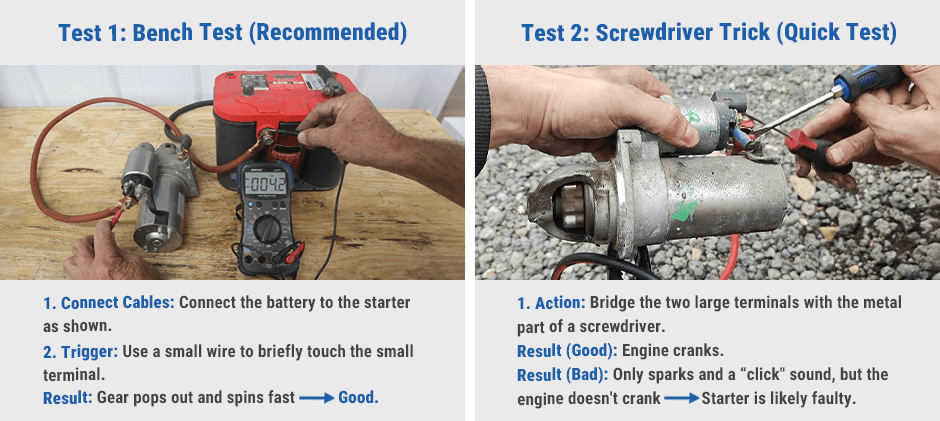If you suspect your starter motor might be failing but aren’t completely sure, this guide is exactly what you need. We’ll walk you through a safe, step‑by‑step process to test and confirm whether the starter motor is really the issue—no advanced mechanical skills required, just a few basic tools and a careful approach.
What You Need to Prepare Before Testing
Before tearing into the motor, check these three quick things first — they’re often the real cause.
1. Check the Battery
Weak batteries cause most starting issues.
- Light test: Turn the key to “ON.” Are the dash lights bright or dim?
- Headlight test: Turn on the headlights, then try to start. If the lights fade or go out, the battery is weak.
- Jump‑start test: If your machine starts with a jump, the starter is fine — your battery isn’t. If the battery is weak, you may need to learn how to use a battery charger or find the right battery for your equipment.
2. Check the Connections
Power can’t flow through dirty or loose cables.
- Look for fuzzy green/white corrosion on battery terminals.
- Wiggle the cables — if they move, they’re too loose.
- Clean corrosion with a wire brush and tighten all clamps — at both battery and starter ends.
3. Listen for the Sounds
Sound clues reveal a lot:
| Sound | Meaning |
|---|---|
| One loud click | Solenoid works, motor doesn’t spin — likely bad starter |
| Rapid click‑click‑click | Weak battery |
| Whirring or grinding | Starter spins, but the gear doesn’t connect |
| No sound | It could be a battery, cable, or ignition issue |
If you’ve ruled out the battery and wiring, and you hear a single click or whir, it’s time to test the starter itself.
Two Easy Ways to Test a Starter Motor
Safety first!
Disconnect the black (–) battery cable.
Park on level ground and set the brake.
Wear safety glasses.
Test 1: The Bench Test
This test checks the starter on the machine.
You’ll need: Wrenches, a charged 12 V battery, jumper cables, and a short wire.
1. Remove the starter. Disconnect cables and unbolt it from the engine.
2. Secure it on the ground. It can jump when powered.
3. Connect cables:
- Black (–) cable → metal starter body
- Red (+) cable → big solenoid post
4. Connect trigger:
- Touch one end of your small wire to the red cable post
- Tap the other end of the small solenoid terminal
Results:
- Shoots out and spins fast → Starter is good
- Nothing → Starter is dead
- Shoots out, no spin → Bad motor
- Spins, no shoot‑out → Bad solenoid
If the starter doesn’t pass, replacement time.
Test 2: The Screwdriver Trick
Use this only for a quick check — it creates large sparks.
You’ll need: A screwdriver with an insulated handle.
- Make sure the machine is in Park/Neutral.
- Locate the starter solenoid (small cylinder on the starter).
- Bridge the two big solenoid posts with the screwdriver.
Results:
- Engine cranks: Starter motor is fine — problem is wiring, relay, or ignition switch.
- Spark and clunk only: Starter motor likely failed.

What to Do Next
- If your starter passed: It’s working! The problem is likely upstream — ignition switch, relay, fuse, or neutral safety switch.
- If your starter failed: That’s your culprit. Replace it confidently, knowing the diagnosis is correct.
Final Thoughts
Troubleshooting a dead machine can feel intimidating, but with a little time and these checks, you can diagnose a bad starter motor yourself — no guessing, no wasted money. You’ve just saved time, frustration, and repair costs.
Now grab the right starter motor replacement and get your machine back to work — right where it belongs. Any questions, FridayParts support team has you covered.
